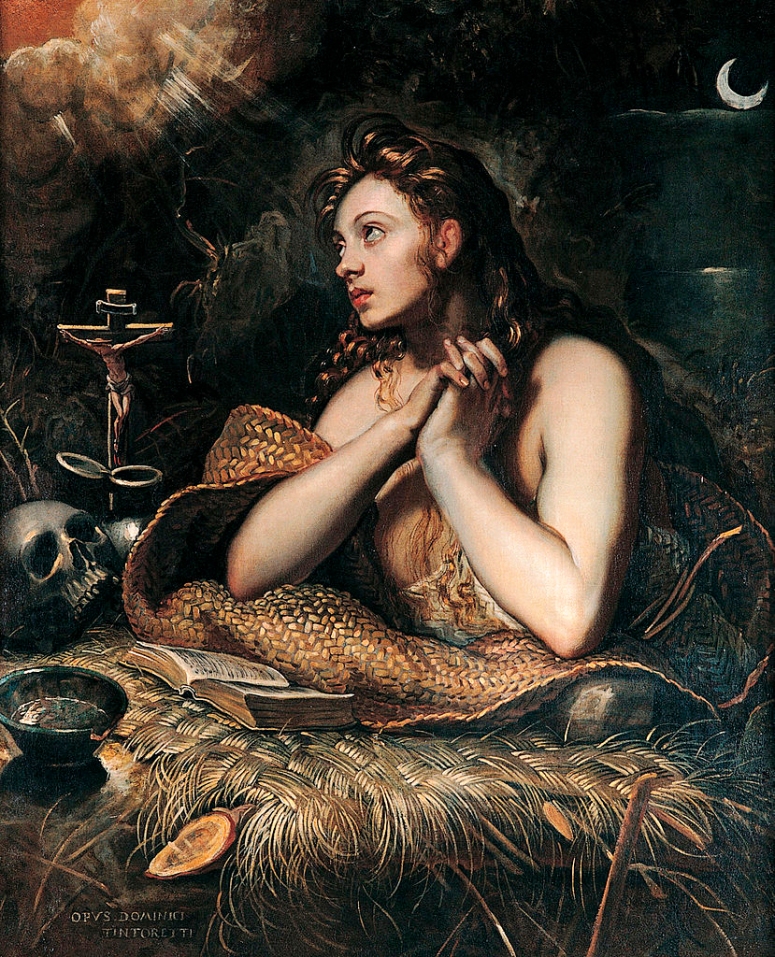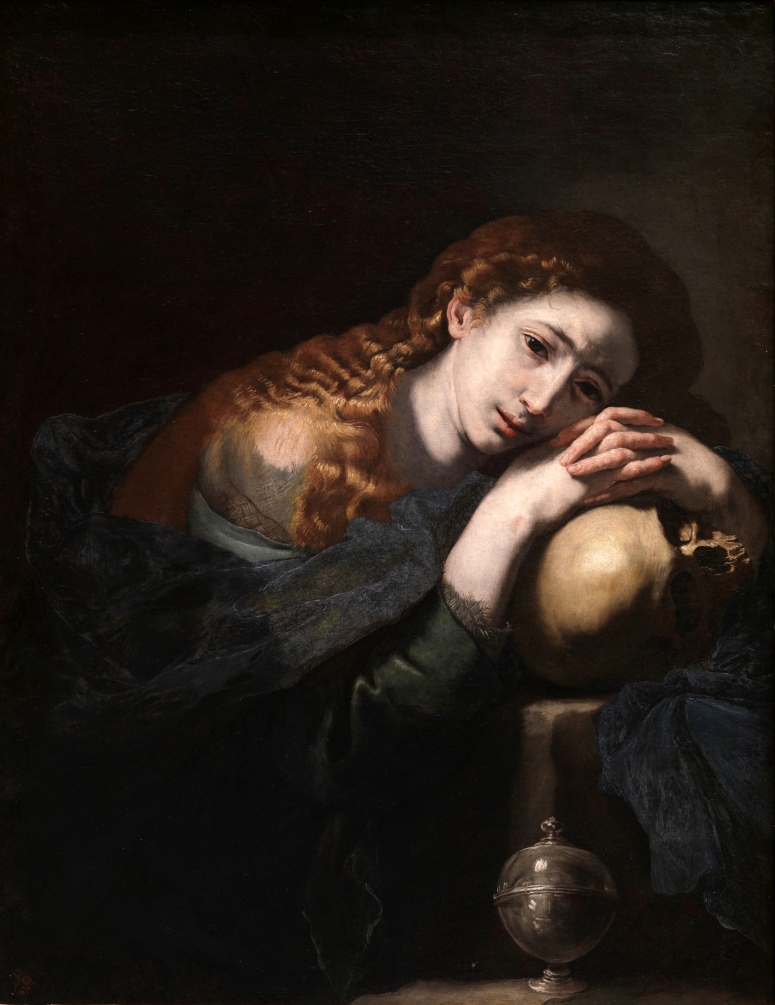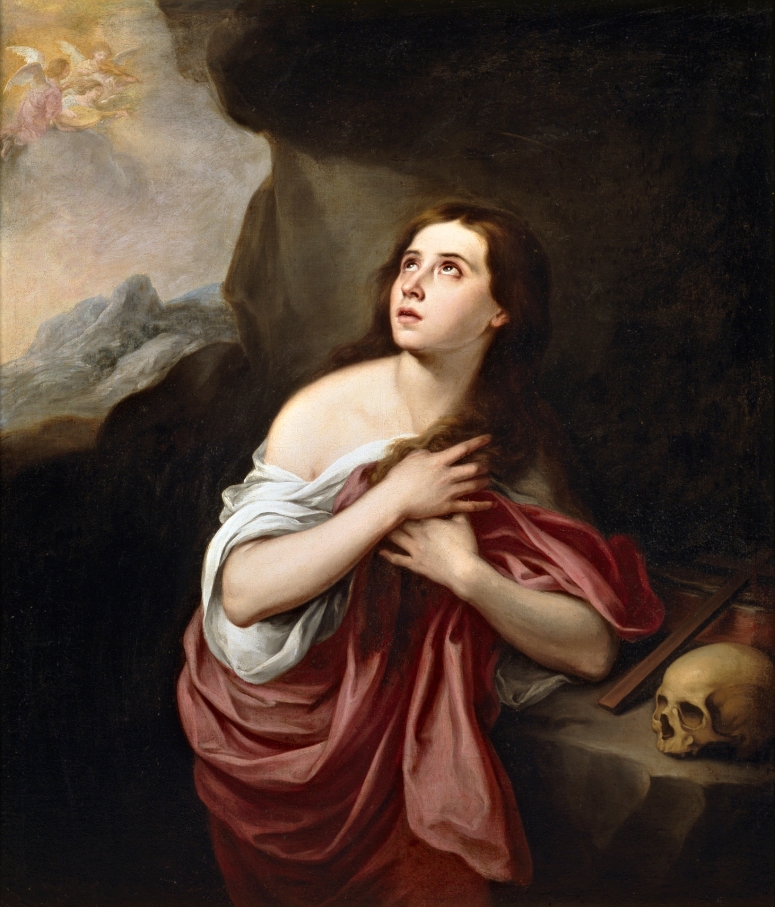Selected paintings from the High Renaissance and Baroque featuring a (non-) penitent Mariam of Magdala
– My younger sister, Ari, was not a Christian, but a shamanistic animist. Anyway, she always had a very deep fondness of Mary (Mariam in Aramaic) Magdalene, as she personally figured her. She had a stamp of her on the nightstand and also, when she was very young, she prayed to her sometimes, trusting that she would look somehow after her.
Regarding this point, to avoid any possible misinterpretation, I have to explain that Ari didn’t thought Mariam from Magdala was a prostitute or loose woman redeemed by her love to Christ:
As a matter of fact, nowhere in the canonical or apocryphal Gospels there is a single mention of the Magdalene as a “sinful” woman of any sort. What all the Gospels say is that she travelled with Jesus as one of his followers, that she witnessed Jesus’ crucifixion and resurrection, and was the first person to testify to it. John and Mark specifically name her as the first person to have seen Jesus after his resurrection. Within the four Gospels she is named at least twelve times, more than most of the apostles.
However, during the Middle Ages, Mary Magdalene was regarded in Western Christianity as a repentant prostitute or promiscuous woman. And this happened because her identity was merged with the identity of the unnamed sinner, who anoints Jesus’ feet in Luke 7:36–50. Mariam from Magdala, the anointing sinner of Luke, and Mary of Bethany –who in John 11:1–2 also anoints Jesus’ feet– were long regarded as the same person.
What the Magdalene is specifically said to have done, along with Mary the mother of James, and Mary Salome is anointing Jesus’ body after his death. Given that she is mentioned here, as almost always, in the first place among close friends and relatives (just as Peter is mentioned first among apostles), this means that she was the nearest and most intimate person to Jesus besides his mother.
So, Ariel, who was a very well-learned and cultivated person, had the Magdalene as the companion or wife of Jesus, and most probably as his most prominent disciple. —[So far to clarify Ariel’s particular interest in that woman, and also to help to understand better the symbolism in the works of art I am showing below.]
Not long before passing away, Ari thought of posting a gallery of paintings inspired in Mariam the Magdalene throughout the centuries. There are many, and many of them are splendid and truly beautiful. She collected only a dozen, and commented seven: two by Doménikos Theotokópoulos (“El Greco”), two by Josep de Ribera (or José de Ribera or Jusepe de Ribera –also Lo Spagnoletto; but he was a Catalan from Xàtiva, València–), one from Bartolomé Esteban Murillo, one anonymous copy of this same painting, and one by Domenico Robusti (best known as Domenico Tintoretto since he was the son of the renowned painter Jacopo Robusti “Tintoretto”).
I post here these seven oils of great merit (plus an eight one at the end), but not any of Ari’s comments on them, given that they are too personal; dealing more with impressions and intimate memories of hers that with the paintings themselves. So, any comments written here –not many, in fact– are my own opinion.
–
Maddalena Penitente, by Domenico Tintoretto – (1598-1602) – (Musei Capitolini, Roma, Italia)
–

–
[Source: Google Art Project files – To see the image in high definition click on it; to see an even larger version -but less true to the atual colours- go here]
–
This is an exquisite work –my favourite among all the 16th and 17th centuries paintings dedicated to Mariam that I know of–, it seems clear that it is more a portrait of some real woman the painter knew than a conventional religious stamp. Even if most –if not all– of the other painters have also chosen pretty women to represent Mariam, this one stands here also for herself; I presume she was not a simple model (and possibly his half-sister Marietta Robusti, also an accomplished painter, as well as a musician, who had died in 1590 at the age of thirty). The work is also charged with some special symbolism not found in any other of the works; like the waning “moon”, which is not the moon despite its reflection on the sea below: it is a reference to the Ottoman Empire, which was a secular menace over the Republic of Venice, homeland of the painter. There are in this painting, as in most of the others I show, the crucifix, the skull, the book, the jars of ointment, but also what seems to me a blurred silhouette of Death on the background, descending from the light above and apparently ready to take her.
–
María Magdalena en el Desierto, by Josep de Ribera (1641) – Museo del Prado, Madrid, España.
–
[Source: Wikimedia Commons – To see the image in high definition go here]
–
Magdalena Penitente, by Josep de Ribera (1635 – 1640) – Museo del Prado, Madrid, España.
–
[Source: Museo Nacional del Prado website]
–
Magdalena Penitente, by Bartolomé Esteban Murillo – (from 1650 until 1665) –Minneapolis Institute of Arts, Minneapolis, Minnesota, USA
& Anonymous copy of Murillo – (XVII century) – Museo del Prado, Madrid, España
–
–
[Sources: Wikimedia Commons & Museo Nacional del Prado website]
–
Magdalena Penitente, by Doménikos Theotokópoulos (“El Greco”) – (1576 -1578) –Magyar Szépmüvészeti Múzeum-Budapest, Hungary
–
I show two different photographs of this great work (the second, less well defined and in lighter blue, with vivid yellow and reddish hues). I tend to believe the first is more true to the original painting, but as I have not seen it directly and thus I cannot be certain, I bring here both images (both from relevant and reliable sources, which certainly puzzles me and I can only explain assuming a cleaning of the oil has been carried out between the dates when the images were taken).
–
[Sources: Version B is from The Google Art Project files; Version A is found on The Yorck Project: 10.000 Meisterwerke der Malerei –and probably coming from the Museum of Fine Arts of Budapest website]
–
Magdalena Penitent, by Doménikos Theotokópoulos (“El Greco”) – (1585 -1590) –Museu d’El Cau Ferrat, Sitges, Catalunya
–
[Source: Wikimedia Commons]
–
Magdalena Penitent, attributed to Doménikos Theotokópoulos (“El Greco”) – (1590s) – Museu de Montserrat, El Bages, Catalunya
This one seems a copy of the first Magdalene by Theotokópoulos shown here, but featuring a rather different –very beautiful– face. Even though I do not see at all the hand and brush of the painter in this oil, I do consider it deserved to be show in my post along with the other works.
[I’ve not yet found the measurements of this oil, but I watched it in person years ago and I clearly recall it was smaller than the Magdalene from Budapest]
–

–
[Source: Diari Ara: http://www.ara.cat/premium/cultura/obres-fortuna-del-Greco-Catalunya_0_1061293864.html]
–
No unauthorised copying or redistribution. All Rights Reserved.








Awesome post on several levels. Beautifully illustrated. Thank you.
LikeLiked by 3 people
Oh!! Thank you very much for your comment and compliment 🙂 ✨
I do really appreciate it!
LikeLike
This post is amazing! Very illustrative piece of history about this enigmatic feminine figure and nice comments, as always 🙂
LikeLiked by 1 person
Thanks dearly for your feedback. A big hug and a kiss ✨
LikeLiked by 1 person